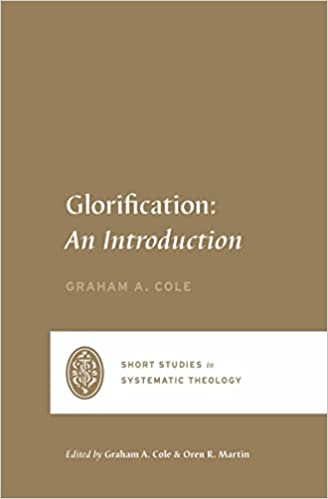A Book Review for Books At a Glance
by Joshua Pack
Glorification is one of the more neglected doctrines in the recent history of the Church. Cole notes early in the book that the last work to specifically address this topic in the evangelical tradition was that of Bernard Ramm in 1963. Given this book’s publishing as of 2022, a surprising gap of nearly 60 years exists between these two works. The aforementioned neglect is likely due to the fact that Scripture often gives only limited insights into what awaits those who believe. This book’s primary focus is acquainting the reader with that which the biblical witness contains on the topic of glorification, but other aspects (such as the views of particular theologians) are visited at different times throughout the book as well to a limited extent.
The book is organized with God as the starting point of glorification, moving through to how we became involved in the work of God as those who would receive glorification, and then examines more of the practical biblical insights concerning the particulars of the process, what awaits those who will be glorified, and what to expect in terms of who will and who will not receive glorification. It quite sensibly begins with God and then explores the ways in which His glory emanates from Himself and is given to His people by the work of Christ.
The text begins with some of what readers can understand on this topic from God Himself. If the glory which believers are to inherit has God as its foundation, then it stands to reason that His glory must first be examined in order to grasp more fully that which awaits those seeking to share in said glory. It is in dealing with the biblical witness that this work shines brightly, avoiding the particulars of denominational or specific theological interpretations of the text and instead simply highlighting the apparent insights which stand to be gained from specific passages. It is made clear from early on that an exhaustive examination of the biblical texts on glorification is not necessarily possible while maintaining the intended purpose of being simply an introduction, so the texts are only some of the highlights of what Scripture has to say on the topic. There are many times, however, when a text with significant theological ramifications is examined with such brevity as to make the reader long for more. I found myself on several occasions surprised at how quickly a passage with serious weight on the topic was mentioned virtually in passing. Perhaps this is part of the goal of the text as an introductory work – to give the reader enough of a taste to desire a much more significant study. In this, it does very well. Readers will undoubtedly wish to know more about glorification by the end of the book. It whets the appetite and provides just enough in the way of answers to encourage more questions.
Some of the biggest ways in which this appetite-whetting plays out are in the central chapters of the book. One might expect to find opportunities to gnaw on some new theological ideas as the text progresses, but those opportunities are fairly limited due to the aforementioned brevity. Glorification: An Introduction achieves its goal of increasing the reader’s familiarity with glorification, but never really gives us the chance to think on the concept to any great extent or walk with the author through many of the implications of a passage. There is very little with which a student of Scripture may disagree, as the vast majority of the book is concerned simply with highlighting key verses and taking a cursory glance at their theological implications.
There are ways in which this text is both introductory and yet requires some existing understanding in order to be fully understood. Terms are often used with the understanding that the reader will process the fullness of ideas (e.g., eschatology, theophanies, etc.) without any further need for explanation. Some ideas, such as aseity, will receive small explanations which help the reader to process without needing the backing of formal training. Although never stated explicitly, this work appears to be aimed primarily at an audience with some degree of existing theological education rather than the average layman. Pastors and seminarians will find this a useful addition to their libraries but will also likely find themselves looking for an additional volume on the topic shortly after having finished it to further explore their questions.
Surprisingly, the book never touches on the sister doctrine of theosis. Possible insights from the early Church are absent as well, instead favoring the insights of modern theologians like N.T. Wright or C.S. Lewis apparently due to their favor within modern evangelical theology (Calvin does have a brief appearance as well). Selecting what material to explore and what to leave is certainly a difficult endeavor with a book of such brevity, but I found myself surprised at these particular omissions.
Many will find in this book a beneficial examination of the biblical evidence for what glorification is and what it will entail. Cole’s avoidance of mere speculation in the interest of that which can be clearly ascertained from Scripture helps to keep this work from becoming an exercise in proving a particular tradition’s views, focusing instead on that which results in edifying theological discussion. Thus readers from all traditions will find this work a worthwhile addition to their libraries.
Joshua Pack
